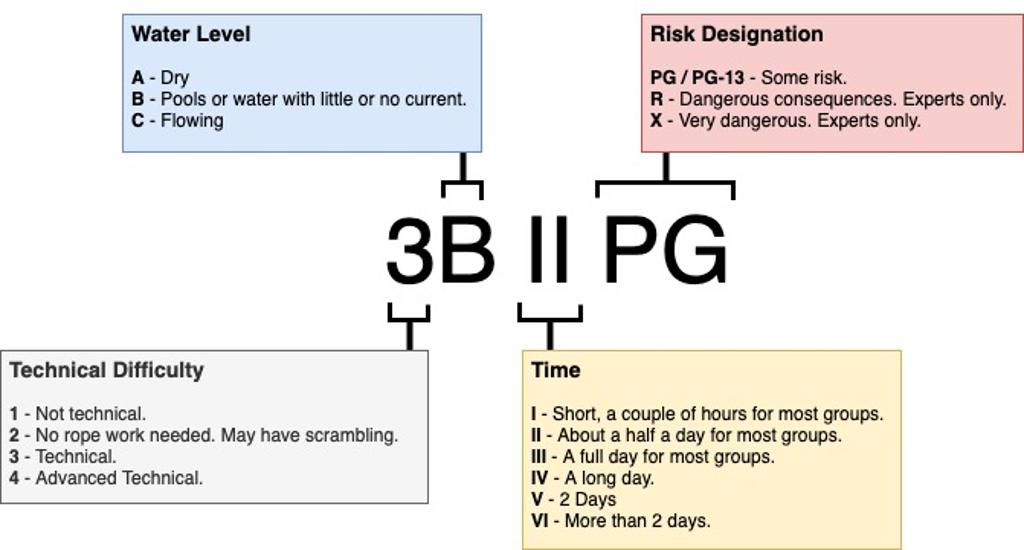Canyon Rating System
Canyoneering is the United States is currently (mostly) rated based on the system defined by the American Canyoneering Association in the early 2000's. It is imprecise, and in my humble opinion, not well suited to the types of canyons generally seen on the Colorado Plateau.
The Rating System
Lets look at an example rating for Canyon XYZ that has a rating of 3B II PG:

The rating is broken up into 4 parts, the technical difficulty (3), the water level (B), the time (II), and additionally a risk designation if needed (PG).
Technical Difficulty
- 1 - Not technical. Think of this as a hike suitable for most. Should not have a risk designation.
- 2 - No rope work needed, but may involve some scrambling. If this has an associated risk designation, falls or slips may have serious consequence or be fatal.
- 3 - Technical. This is the vast majority of canyons on the Colorado Plateau. This defines technical canyons that will require rappelling and possible anchor skills.
- 4 - Advanced Technical. This is used to denote canyons that require more advanced technical skills, such as difficult anchors, keeper potholes, big multi-stage rappels, etc..
Water Level
- A - Completely dry.
- B - Pools or water with no current. (Or very little.) This covers most canyons on the Colorado Plateau. A "B" canyon may have a few small pools, or require swimming for long distances. Be sure to check the description to see how much water is likely to be encountered and if a wetsuit is required. Some 3B canyons can be done without a wetsuit, but many will require a wetsuit especially in cooler times of the year.
- C - Canyons with flowing water. A good example of a "C" canyon would be Kolob in Zion. In most times of the year, it is flowing and requires flowing water skills. If you are not accustomed to flowing water canyons, get the skills before venturing into them, as they require a different skill set than "A" or "B" canyons. Most "C" canyons require thick wetsuits to insulate from the cold water exposure. All members of the group must be skilled. A stuck device or problem rappelling in a flowing water canyon can quickly lead to drowning or death by exposure.
Time
The time designation is a rough guideline. On this site, a more specific hour range is used, and in the description, specific time for the approach, canyon, and exit is generally used.
- I - Short, a couple of hours for most groups.
- II - About a half a day for most groups.
- III - A full day for most groups.
- IV - A long day. Bring a headlamp and avoid these in the shorter winter days.
- V - More than a day, generally two days.
- VI - Not frequently seen on the Colorado Plateau, these require 2+ full days.
Risk Designation (if needed)
This is an important one, and helps refine the difficulties encountered. In the slots on Southern Utah, many involve climbing, stemming, and squeezing above constrictions. The risk designation helps give a sense of the difficulty of the climbing, and what the consequences of a fall would be. Be very wary of canyons with risk designations. Even in a PG or PG-13 canyon, a fall very well may be fatal by the time a rescue is mounted. Any canyon with a risk designator requires sound judgement. NOT SUITABLE FOR BEGINNERS EVEN WITH COMPETENT LEADERSHIP.
- PG or PG-13 - These are canyons with some climbing or other difficulties that may have serious consequences, but are within most experienced canyoneers abilities.
- R-, R, R+ - Dangerous consequences. Experts only. An R+ is harder than an R, which is harder than an R-
- X-, X, X+, XX, etc. - Very dangerous. Experts only, with solid skills. At this level, climbing experience helps. Different people use the different X categories differently. Essential all X canyons require expert level skills. Read the description for specific difficulties of a canyon.
Climbing Ratings
Some canyons will also include a climbing rating, for instance 3B II R 5.6. This (5.6 in the example) is meant to denote technical climbing level needed using the Yosemite Decimal System. Take this with a grain of salt. In my experience, the climbing rating in canyons varies WIDELY, and is generally not reliable at all. One mans 5.6 is another mans 5.0, and yet another mans 5.10. The movement is very different than climbing and often people specifying the rating don't have enough climbing experience to properly rate the difficulties.
